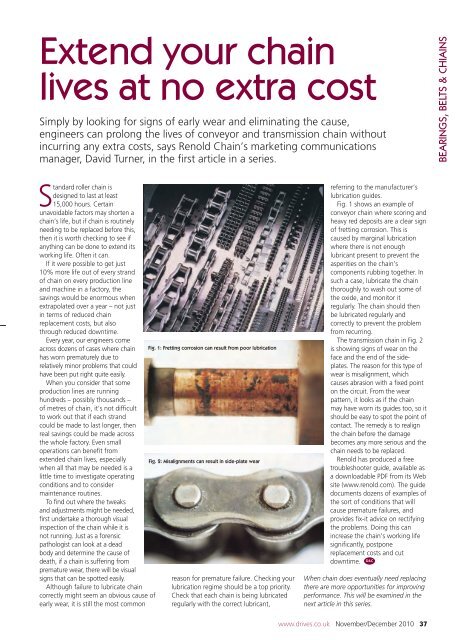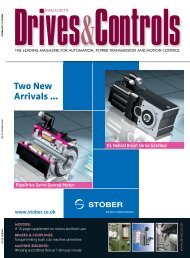New Danfoss VLT® Decentral Drive E cient, reliable and powerful
New Danfoss VLT® Decentral Drive E cient, reliable and powerful
New Danfoss VLT® Decentral Drive E cient, reliable and powerful
Create successful ePaper yourself
Turn your PDF publications into a flip-book with our unique Google optimized e-Paper software.
Extend your chain<br />
lives at no extra cost<br />
Simply by looking for signs of early wear <strong>and</strong> eliminating the cause,<br />
engineers can prolong the lives of conveyor <strong>and</strong> transmission chain without<br />
incurring any extra costs, says Renold Chain’s marketing communications<br />
manager, David Turner, in the first article in a series.<br />
BEARINGS, BELTS & CHIAINS<br />
St<strong>and</strong>ard roller chain is<br />
designed to last at least<br />
15,000 hours. Certain<br />
unavoidable factors may shorten a<br />
chain’s life, but if chain is routinely<br />
needing to be replaced before this,<br />
then it is worth checking to see if<br />
anything can be done to extend its<br />
working life. Often it can.<br />
If it were possible to get just<br />
10% more life out of every str<strong>and</strong><br />
of chain on every production line<br />
<strong>and</strong> machine in a factory, the<br />
savings would be enormous when<br />
extrapolated over a year – not just<br />
in terms of reduced chain<br />
replacement costs, but also<br />
through reduced downtime.<br />
Every year, our engineers come<br />
across dozens of cases where chain<br />
has worn prematurely due to<br />
relatively minor problems that could<br />
have been put right quite easily.<br />
When you consider that some<br />
production lines are running<br />
hundreds – possibly thous<strong>and</strong>s –<br />
of metres of chain, it’s not difficult<br />
to work out that if each str<strong>and</strong><br />
could be made to last longer, then<br />
real savings could be made across<br />
the whole factory. Even small<br />
operations can benefit from<br />
extended chain lives, especially<br />
when all that may be needed is a<br />
little time to investigate operating<br />
conditions <strong>and</strong> to consider<br />
maintenance routines.<br />
To find out where the tweaks<br />
<strong>and</strong> adjustments might be needed,<br />
first undertake a thorough visual<br />
inspection of the chain while it is<br />
not running. Just as a forensic<br />
pathologist can look at a dead<br />
body <strong>and</strong> determine the cause of<br />
death, if a chain is suffering from<br />
premature wear, there will be visual<br />
signs that can be spotted easily.<br />
Although failure to lubricate chain<br />
correctly might seem an obvious cause of<br />
early wear, it is still the most common<br />
Fig. 1: Fretting corrosion can result from poor lubrication<br />
Fig. 2: Misalignments can result in side-plate wear<br />
reason for premature failure. Checking your<br />
lubrication regime should be a top priority.<br />
Check that each chain is being lubricated<br />
regularly with the correct lubricant,<br />
referring to the manufacturer’s<br />
lubrication guides.<br />
Fig. 1 shows an example of<br />
conveyor chain where scoring <strong>and</strong><br />
heavy red deposits are a clear sign<br />
of fretting corrosion. This is<br />
caused by marginal lubrication<br />
where there is not enough<br />
lubricant present to prevent the<br />
asperities on the chain’s<br />
components rubbing together. In<br />
such a case, lubricate the chain<br />
thoroughly to wash out some of<br />
the oxide, <strong>and</strong> monitor it<br />
regularly. The chain should then<br />
be lubricated regularly <strong>and</strong><br />
correctly to prevent the problem<br />
from recurring.<br />
The transmission chain in Fig. 2<br />
is showing signs of wear on the<br />
face <strong>and</strong> the end of the sideplates.<br />
The reason for this type of<br />
wear is misalignment, which<br />
causes abrasion with a fixed point<br />
on the circuit. From the wear<br />
pattern, it looks as if the chain<br />
may have worn its guides too, so it<br />
should be easy to spot the point of<br />
contact. The remedy is to realign<br />
the chain before the damage<br />
becomes any more serious <strong>and</strong> the<br />
chain needs to be replaced.<br />
Renold has produced a free<br />
troubleshooter guide, available as<br />
a downloadable PDF from its Web<br />
site (www.renold.com). The guide<br />
documents dozens of examples of<br />
the sort of conditions that will<br />
cause premature failures, <strong>and</strong><br />
provides fix-it advice on rectifying<br />
the problems. Doing this can<br />
increase the chain’s working life<br />
significantly, postpone<br />
replacement costs <strong>and</strong> cut<br />
downtime.<br />
D&C<br />
When chain does eventually need replacing<br />
there are more opportunities for improving<br />
performance. This will be examined in the<br />
next article in this series.<br />
www.drives.co.uk November/December 2010 37




